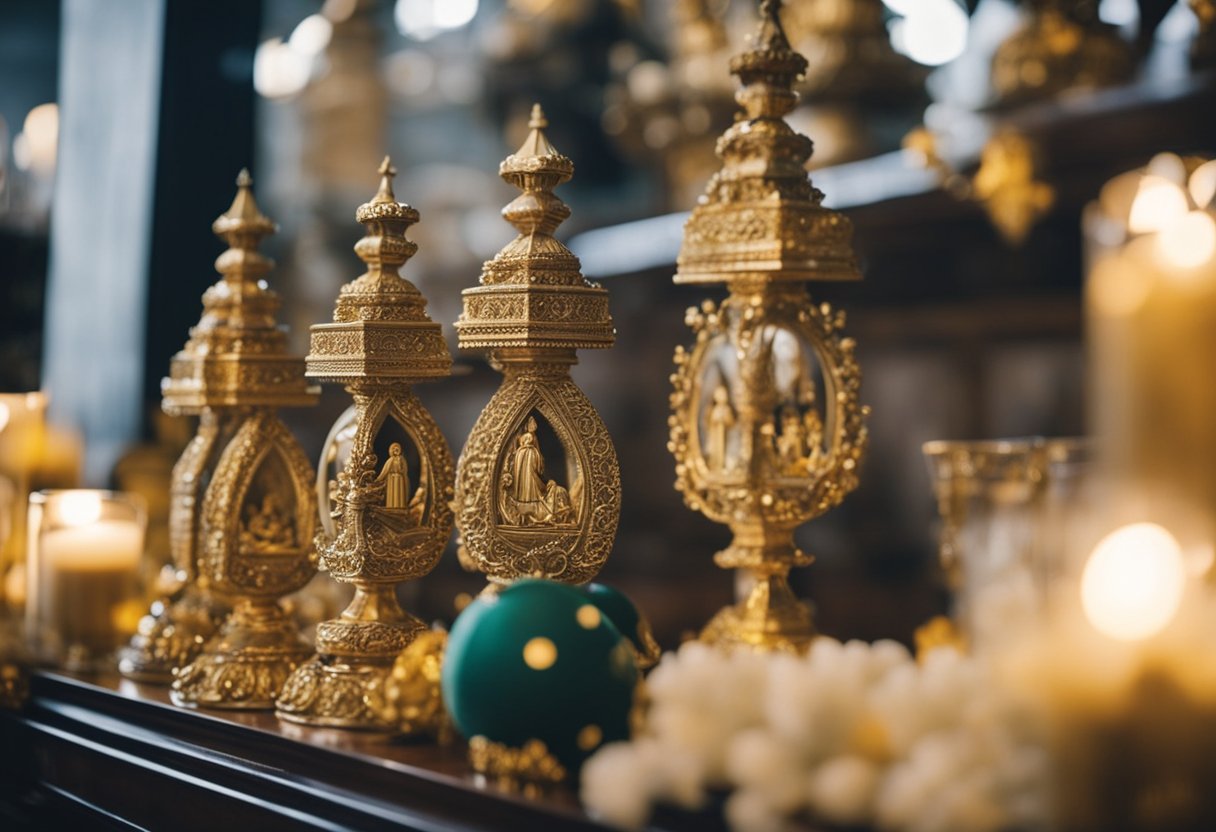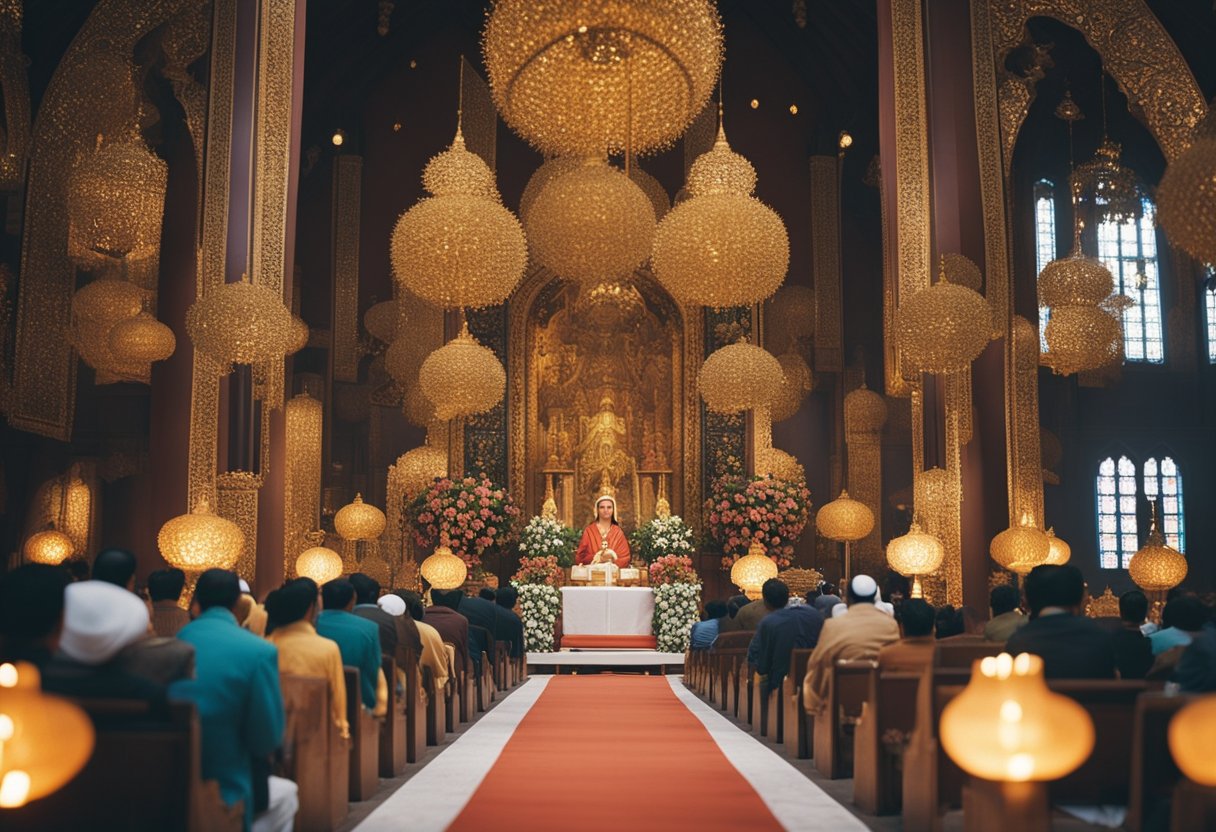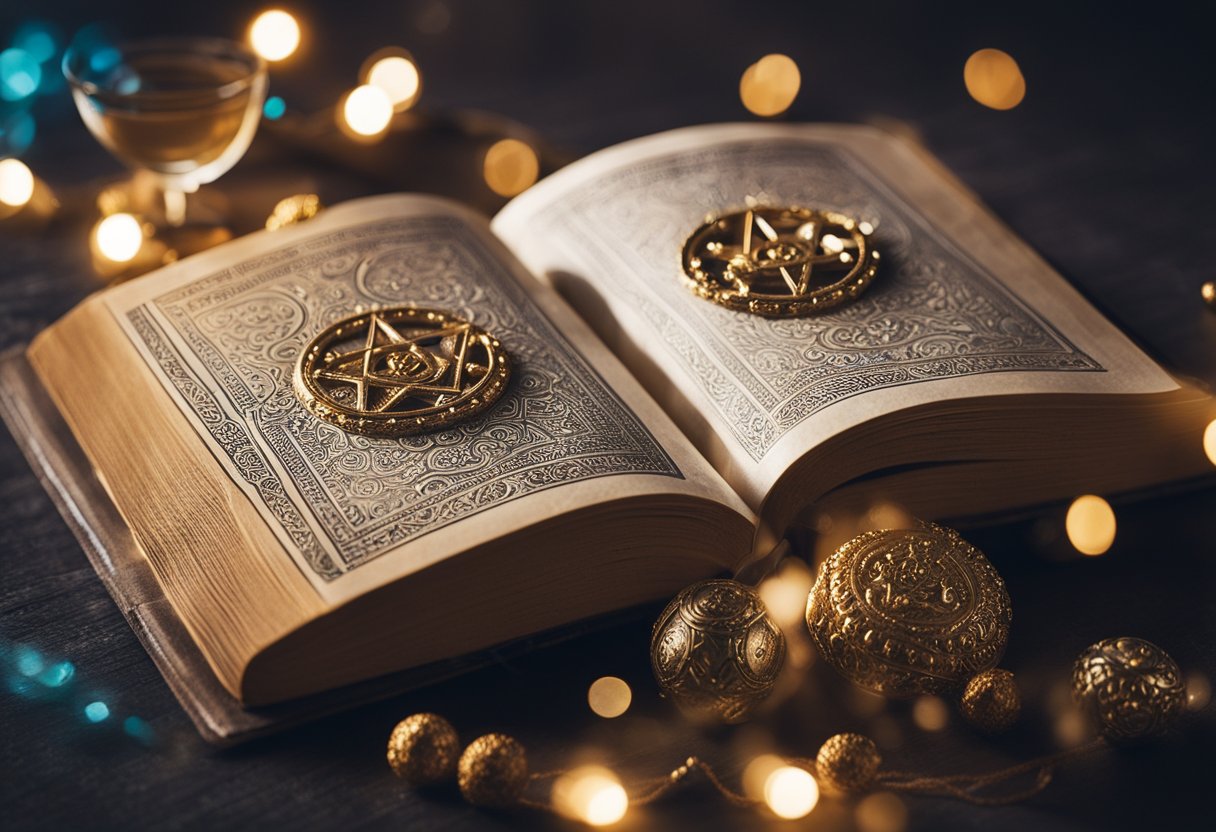At the heart of these traditions lies the celebration of faith, which often serves to unite believers and reaffirm their commitment to a specific belief system. Throughout the year, various faith celebrations take place, allowing followers to express their devotion and honor the teachings, sacred texts, and historical events central to their faith. By understanding the underlying beliefs and customs associated with these celebrations, we can more effectively engage in interfaith dialogue and foster mutual respect among diverse religious communities.
In this age of ever-increasing globalization and interconnectedness, it is essential for us to be aware of the significance and meaning behind the many religious traditions and practices that we encounter in our day-to-day lives. By celebrating faith and participating in these diverse traditions, we can contribute to a more harmonious, open, and pluralistic world.
Key Takeaways
- Religious traditions and faith celebrations strengthen spiritual beliefs and communities.
- Engaging in interfaith dialogue and understanding different belief systems promotes respect among diverse religious communities.
- In the modern world, participating in and appreciating diverse religious traditions fosters openness and pluralism.
Understanding Religious Traditions
As a passionate learner about religious traditions, I want to share my knowledge on some of the world’s major faiths and their unique rituals, practices, and beliefs. Understanding these various religious traditions enables us to appreciate the rich spiritual heritage of our global community. In this section, I will briefly explain the core beliefs and traditions of some major religions.
Christianity
Christianity has its roots in the life and teachings of Jesus Christ and revolves around a belief in his resurrection and the forgiveness of sin. Christians celebrate important events in Jesus’ life, such as his birth during Christmas, and his resurrection on Easter Sunday. They also participate in prayer and worship within churches and various religious practices based on biblical teachings.
Judaism
Judaism is the oldest monotheistic religion, tracing its origins back to Abraham, Isaac, and Jacob. The Jewish faith places great emphasis on the study and observance of the Torah and its laws. Various rituals and celebrations like the Sabbath, Rosh Hashanah, and Passover mark significant moments in Jewish history and express gratitude towards God.
Islam
Islam is based on the teachings of Prophet Muhammad and is centered around the belief in one God, Allah. Muslims observe the five pillars of Islam: Shahada (faith), Salat (prayer), Zakat (charity), Sawm (fasting during Ramadan), and Hajj (pilgrimage to Mecca). They gather for communal prayers in mosques and celebrate various festivals such as Eid al-Fitr and Eid al-Adha.
Hinduism
Hinduism is a complex religion with many gods and goddesses, yet it is often considered a monotheistic faith as all gods are believed to emanate from a single Supreme Being, known as Brahman. Hindus observe rituals such as daily prayer, various rites of passage, and celebrate many festivals like Diwali and Holi. They believe in the concept of karma, and the cycle of rebirth, known as samsara.
Buddhism
Buddhism, founded by Siddhartha Gautama, also known as the Buddha, centers around practices designed to end suffering and achieve enlightenment. Buddhists follow the Noble Eightfold Path and focus on meditation, morality, and wisdom. They celebrate core events in the Buddha’s life like his birth, enlightenment, and passing during the festival of Vesak.
Sikhism
Sikhism, founded by Guru Nanak, emphasizes belief in one God, the importance of community service, and living an honest life. Sikhs worship at gurdwaras, where they participate in prayers and recite hymns from their holy scripture, Guru Granth Sahib. Festivals like Vaisakhi and Diwali are celebrated by the Sikh community.
Jainism
Jainism, an ancient Indian religion, teaches the principles of non-violence, truth, non-stealing, celibacy, and non-attachment. Jains engage in meditation and strict dietary practices, adhering to a vegetarian diet. They celebrate festivals like Mahavir Jayanti, Paryushan, and Diwali.
Zoroastrianism
Zoroastrianism centers around the teachings of the prophet Zoroaster (Zarathustra) and is one of the oldest monotheistic faiths. Zoroastrians believe in one supreme God, Ahura Mazda. They observe various rituals such as daily prayers and seasonal celebrations like Nowruz, the Zoroastrian New Year.
Taoism
Taoism, originating in China, is centered on the philosophical teachings of Laozi and focuses on harmony with the natural world. Taoists practice meditation, mindfulness, and reverence for the Tao, the underlying natural order of existence. Festivals like the Chinese New Year and the Dragon Boat Festival are celebrated within the Taoist community.
Baha’i
The Baha’i faith, based on the teachings of Baha’u’llah, emphasizes the unity of all religions and promotes universal peace. Baha’is gather at local spiritual assemblies and observe several holy days, such as Naw-Ruz, the Baha’i New Year, and the Feast of Ridvan.
Native American
Native American spiritual traditions are diverse due to the range of distinct tribes and cultures. However, common themes include deep reverence for nature, ancestors, and spirits. Rituals and ceremonies, such as the Sun Dance and vision quests, create opportunities for spiritual connection and healing.
Paganism
Paganism is an umbrella term for a variety of nature-focused and polytheistic spiritual practices. Modern paganism, also known as Neo-Paganism, includes Wicca, Druidry, and various pagan witchcraft traditions. Pagans celebrate events such as the solstices, equinoxes, and cross-quarter days according to the Wheel of the Year.
Significant Faith Celebrations
Christian Celebrations
As a Christian, I often celebrate events like Christmas, the birth of Jesus Christ, and Easter, which commemorates the resurrection of Jesus from the dead. We also observe other important days like Advent, the period of preparation for the celebration of Jesus’ birth, and Pentecost, which marks the descent of the Holy Spirit upon the apostles.
Jewish Celebrations
I appreciate Jewish traditions and their rich history. Key Jewish celebrations include Passover, Rosh Hashanah, and Yom Kippur. Passover marks the liberation of the Israelites from Egyptian slavery, while Rosh Hashanah is the Jewish New Year. Yom Kippur, known as the Day of Atonement, is a time for reflection and repentance.
Muslim Celebrations
In the Muslim faith, I recognize the importance of celebrations like Eid al-Fitr and Eid al-Adha. Eid al-Fitr is a festival that marks the end of Ramadan, the month of fasting. On the other hand, Eid al-Adha is the Feast of Sacrifice and commemorates the willingness of Ibrahim to sacrifice his son in obedience to God’s command.
Hindu Celebrations
Hinduism has a wide variety of celebrations rooted in its diverse traditions. As an admirer of their faith, I’ve learned about some important festivals like Diwali, the Festival of Lights; Holi, the Festival of Colors; and Navratri, a nine-night festival dedicated to the goddess Durga.
Buddhist Celebrations
From my understanding of Buddhist traditions, key celebrations include Vesak, the birth, enlightenment, and death of the Buddha; Bodhi Day, which celebrates the Buddha’s enlightenment; and Losar, the Tibetan New Year.
Sikh Celebrations
As a follower of the Sikh faith, I take part in celebrations like Vaisakhi, which marks the birth of the Khalsa and the Sikh New Year; and Guru Nanak Jayanti, the birth anniversary of Guru Nanak, the founder of Sikhism.
Jain Celebrations
I appreciate Jainism for its emphasis on nonviolence and compassion. Some key Jain celebrations include Mahavir Jayanti, the birth anniversary of Lord Mahavir; and Paryushana, a time for fasting, reflection, and seeking forgiveness.
Zoroastrian Celebrations
In Zoroastrianism, some significant celebrations I’ve learned about are Nowruz, the Persian New Year; and Zartosht No-Diso, a day commemorating the death anniversary of the prophet Zoroaster.
Taoist Celebrations
As an admirer of Taoism, I find it interesting to learn about their celebrations like the Chinese New Year and the Qingming Festival, a time for honoring ancestors through various rituals.
Baha’i Celebrations
In the Baha’i faith, I value the celebration of the birth of Baha’u’llah, the founder of the Baha’i faith, as well as the Feast of Ridvan, which commemorates Baha’u’llah’s declaration of his prophetic mission.
Native American Celebrations
Native American spiritual traditions are incredibly diverse, but some commonly celebrated events include the Winter Solstice, marking the shortest day and longest night of the year, and various powwows or tribal gatherings.
Pagan Celebrations
I appreciate the Earth-based focus of Pagan celebrations like Beltane, which marks the beginning of summer, and Samhain, celebrated as the end of the harvest season and the start of the darker half of the year.
Participating in Religious Traditions
Christian Practices
In my experience, Christian practices involve attending church services, celebrating religious holidays like Easter and Christmas, and studying the Bible. I have witnessed love, devotion, and compassion exhibited by Christians during these celebrations. Prayer and worship form crucial aspects of their faith.
Jewish Practices
When participating in Jewish practices, I observed Sabbath (Shabbat) celebrations, studied the Torah, and took part in holidays such as Hanukkah and Passover. The Jewish faith emphasizes the covenant between God and the people, with religious observance reflecting a deep sense of reverence and trust.
Muslim Practices
As I learned about Muslim practices, I came to understand the importance of the Five Pillars of Islam, which include prayer, fasting during Ramadan, faith declaration, almsgiving, and the pilgrimage to Mecca. Muslims honor religious texts like the Quran and demonstrate their devotion through worship and adherence to religious guidelines.
Hindu Practices
In Hindu practices, I observed diverse rituals and traditions, including celebrating festivals like Diwali and Holi. The primary focus of this faith lies in devotion, which often involves the worship (puja) of different deities. Hindus express their spiritual convictions by reading sacred texts, such as the Vedas and the Bhagavad Gita.
Buddhist Practices
As I studied Buddhist practices, I learned about the Four Noble Truths and the Eightfold Path, which guide followers towards spiritual enlightenment. I experienced meditative practices and observed how Buddhists cultivate compassion and love, fostering a sense of peace and harmony with nature and their surroundings.
Sikh Practices
Upon exploring Sikh practices, I found that their faith emphasizes the importance of prayer, community service, and social equality. The sacred text, Guru Granth Sahib, serves as a spiritual guide for Sikhs. Visiting a Sikh temple (Gurdwara) allowed me to experience their welcoming nature and religious hospitality.
Jain Practices
Jainism, a religion promoting non-violence and reverence for nature, has taught me about its core principles of Ahimsa, Anekantavada, and Aparigraha. It was inspiring to see Jain practitioners upholding these tenets in their daily lives. I also observed their dedication to spiritual study and asceticism.
Zoroastrian Practices
While participating in Zoroastrian practices, I engaged in prayer, studied sacred texts such as the Avesta, and celebrated holidays such as Norouz. Followers of this faith express their convictions through worship and community gatherings, emphasizing the importance of good thoughts, words, and deeds.
Taoist Practices
In my exploration of Taoist practices, I discovered the central role of personal harmony and balance achieved through meditation and the adherence to the principles outlined in the Tao Te Ching. The focus on nature as a divine force and the cultivation of inner peace resonated with me.
Baha’i Practices
The Baha’i faith emphasizes unity, equality, and the spiritual growth of its followers. I experienced the significance of prayer, meditation, and the study of religious texts in this faith. Baha’is come together in devotional gatherings and strive to promote global peace and the betterment of humanity.
Native American Practices
As I delved into Native American practices, I found various spiritual beliefs and rituals tied to nature and ancestral connections. The importance given to the interconnectedness of all living beings has shaped my understanding of the natural world and influenced my perspective on life.
Pagan Practices
Finally, in Pagan practices, I learned about diverse spiritual paths and rituals involving earth-based spirituality and the worship of various deities. Observing Pagan practices offered me insights into the importance of nature, personal empowerment, and the fostering of community through shared rituals and traditions.
Symbols and Artifacts in Faith Celebrations

Christian Symbols
In Christianity, various symbols and artifacts play an essential role in faith celebrations. The cross is a central symbol, representing the crucifixion and resurrection of Jesus Christ. Altars are used as a focal point for worship and prayer. During Christmas, nativity scenes depict the birth of Jesus, while Easter celebrations often include crosses adorned with flowers to symbolize Jesus’ victory over death.
Jewish Symbols
Jewish religious celebrations feature symbols such as the menorah, a seven-branched candelabrum that represents the miracle of the oil in the Hanukkah story. The Star of David is another well-known symbol, representing the connection between God and the Jewish people. In rituals like Passover, the Seder plate holds symbolic foods that tell the story of the Israelites’ exodus from Egypt.
Muslim Symbols
In Islam, the star and crescent symbolize faith and the unity of the Muslim community. Prayer rugs are used during the five daily prayers, which are an essential part of Islamic life. Additionally, the Kaaba in Mecca is an important symbol, as it represents the direction of prayer and is the focal point of the Hajj pilgrimage.
Hindu Symbols
Hinduism has a rich array of symbols and artifacts used in religious celebrations. The om symbol represents the sacred sound of the universe, while the lotus flower symbolizes purity and divine beauty. Deities in Hinduism, such as Ganesh and Shiva, have their own unique symbols and are often featured in religious artwork and sculptures. India is a significant center of Hinduism and its celebrations.
Buddhist Symbols
In Buddhism, the dharma wheel symbolizes the Eightfold Path and the teachings of the Buddha. Prayer flags and prayer wheels are also essential artifacts in Buddhist celebrations, spreading blessings and goodwill. Statues of Buddha, bodhisattvas, and other deities are often placed on altars, surrounded by offerings of light, incense, and flowers.
Sikh Symbols
Sikhism features various symbols, including the Khanda, which represents the unity of God and the four pillars of Sikh belief. The Guru Granth Sahib, the holy scripture of Sikhism, is an essential artifact used in religious ceremonies and placed on a raised platform during worship.
Jain Symbols
In Jainism, the swastika symbolizes the four states of existence: heavenly beings, human beings, animals, and hellish beings. It also represents the cycle of birth, death, and rebirth. Mahavira, the last Tirthankara, is often depicted in artwork and statues used in Jain religious celebrations.
Zoroastrian Symbols
Zoroastrianism originated in ancient Persia, now Iran. Significant symbols include the Faravahar, which represents the human soul’s connection to the divine and the eternal flame, symbolizing the purity of fire. Fire temples and altars hold ceremonial flames, which are crucial in Zoroastrian rituals.
Taoist Symbols
In Taoism, the yin-yang symbol represents the balance and harmony of opposite forces in the universe. Other essential symbols include the Eight Trigrams, which are used in divination practices and represent various natural elements. Taoist temples often feature intricate artwork and statues of deities such as Laozi and the Jade Emperor.
Baha’i Symbols
The Baha’i faith uses a nine-pointed star as its primary symbol, representing the unity and the coming together of the world’s major religions. Baha’i Houses of Worship are designed with distinct architectural elements, fusing diverse cultural influences into a shared space for prayer and reflection.
Native American Symbols
In Native American spirituality, symbols vary widely across different tribes and regions. However, some common elements include the Medicine Wheel, which represents the interconnectedness of life and the four directions, and the Tree of Life, symbolizing spiritual growth and ancestral connections. Rituals and ceremonies often incorporate natural elements such as feathers, stones, and plants.
Pagan Symbols
Paganism is an umbrella term for various pre-Christian belief systems, and its symbols are equally diverse. The pentagram, representing the five elements of earth, air, fire, water, and spirit, is a widely recognized symbol in modern pagan practices. Nature is heavily emphasized in pagan rituals, with celebrations often coinciding with the solstices, equinoxes, and other seasonal markers.
Religious Traditions and the Modern World

Religion is a constantly evolving aspect of human culture. Globalization, increasing diversity, and the rise of technology have brought about significant changes to religious traditions and practices. In this section, we will explore the changing religious landscape, the role of inclusion in religion, and how technology is impacting religious practice.
Changing Religious Landscape
In recent years, we have witnessed a shift in the religious landscape. With increased globalization and migration, religious communities are becoming more diverse. Inclusion of various beliefs and practices within religious institutions has become a priority. For example, Muslims in Western countries have needed to balance their religious obligations with the norms and practices of their new environment. This has led to the emergence of new interpretations and rituals, creating a more dynamic religious landscape.
Inclusion in Religion
One of the main areas in which religion has evolved and adapted in modern times is the inclusion of a broader range of individuals, notably from the LGBTQ+ community. Many religious institutions have begun to reconsider old beliefs and practices. For instance, the United Methodist Church has made significant efforts to become more inclusive, affirming the value of LGBTQ+ individuals within their congregations and advocating for their full participation in religious life. This inclusion has encouraged more openness and understanding, fostering the growth of an increasingly diverse and accepting religious community.
Religion and Technology
Technology has had a significant impact on how religious traditions and practices are observed in the modern world. It has facilitated the dissemination of religious knowledge, engagement in sacred rituals, and the expression of one’s faith, often beyond the confines of a traditional religious setting. Social media and online platforms have also provided an avenue for people to connect and share their beliefs, opening up new possibilities for interfaith dialogue and understanding.
APIs (application programming interfaces) have further revolutionized the way individuals access religious texts and resources, allowing them to engage more deeply and meaningfully with their respective traditions. As a result, technology has made religion more accessible and relevant to a wider audience, while simultaneously enabling the development of new forms of religious expression and practice.
In conclusion, the modern world is bringing about significant changes to religious traditions and practices. By embracing diversity and harnessing the power of technology, religion is evolving and adapting to the needs of contemporary global society.
Frequently Asked Questions

What are some examples of faith celebrations across different religions?
In Christianity, some of the major faith celebrations include Christmas, which marks the birth of Jesus Christ, and Easter, which commemorates his resurrection. In Islam, celebrations like Eid al-Fitr and Eid al-Adha mark the end of Ramadan and the culmination of the Hajj pilgrimage, respectively. In Judaism, important faith celebrations include Passover, commemorating the liberation of the Israelites from slavery, and Hanukkah, the Festival of Lights, celebrating the miracle of the Temple’s oil lasting eight days.
How can one participate respectfully in religious events?
To participate respectfully in religious events, it is essential to understand the significance and customs associated with that particular event. When attending a religious service or ceremony, dress modestly and respectfully. Listen and engage with the religious teachings being shared, and be open to learning from others. Make sure to follow any guidelines or instructions provided by the organizers or leaders of the event. It’s also important to engage in interfaith conversations with an open mind, respecting others’ beliefs and traditions.
What is the history behind major religious holidays?
The history behind major religious holidays often revolves around significant events or stories in religious texts. For example, Easter in Christianity marks the resurrection of Jesus Christ, whereas Eid al-Adha in Islam commemorates the willingness of the Prophet Ibrahim to sacrifice his son as an act of obedience to God. These holidays not only celebrate pivotal moments in religious history but also serve as reminders of the values and teachings upheld by the respective faith communities.
How do culture and tradition influence religious practices?
Culture and tradition play a significant role in shaping and influencing religious practices. Local customs, art, music, and language can shape the way religious events are celebrated, while traditional foods, clothing, and customs can become integral to religious observances. As religious communities evolve and adapt, they often incorporate elements from the local culture, creating unique expressions of faith that hold deep significance for the adherents.
How do religious traditions vary within the same faith?
Religious traditions can vary within the same faith based on factors such as geography, cultural influences, and differing interpretations of religious texts. For instance, within Islam, there are various sects such as Sunni and Shia, and within Christianity, there are denominations like Catholicism, Protestantism, and Eastern Orthodoxy. These variations can lead to different practices, customs, and celebrations within the same faith, reflecting the diversity and richness present in the spectrum of human belief.
What role do festivals play in religious teachings?
Festivals play a vital role in religious teachings by providing an opportunity for communities to come together to reaffirm their faith, retell stories, and pass on lessons to future generations. Through rituals, prayers, and artistic expressions, these events help to deepen individuals’ understanding and connection to their religious tradition. Additionally, festivals often serve as a means of outreach, as they can be occasions to invite others to learn about and participate in the faith.






